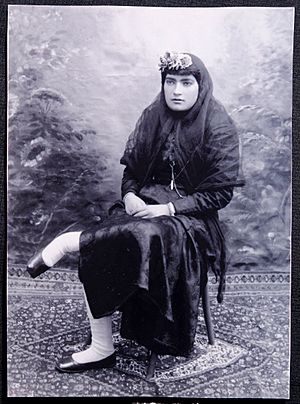Maryam Amid facts for kids
Quick facts for kids
Maryam Amid-Semnani
|
|
|---|---|
| Persian: مریم عمید سمنانی | |

Maryam Amid-Semnani
|
|
| Born | 1881/1882 |
| Died | 1919 |
| Occupation | intellectual, journalist |
| Known for | Civil rights advocacy |
Maryam Amid-Semnani (Persian: مریم عمید سمنانی) was an important Iranian thinker and journalist. She lived in the early 1900s. In Iran, people remember her for starting Shokufeh, a very important magazine for women. She also created the Iranian Women's Society. This group grew to have about 5,000 members.
Contents
Early life
Maryam Amid-Semnani was born in Semnan, a city in north-central Iran. This was during the Qajar era, a time when kings ruled Iran. She was the third daughter of Mir Seyed Razi Semnani and Mirza Ibrahim Amid al-Saltanah. Her father was a doctor to the Shah (king) of Persia. He was also the first person to represent Semnan in the National Assembly.
Maryam learned a lot from her father at home. She studied French and Photography. When she was 16, her family arranged for her to marry Prince Mirza Emad al-Saltanah Salvar. Maryam did not want this marriage. She worked hard and got a divorce after just one year.
Seven years later, she married an intellectual named Qawamul Hakmah. They had two children together. After seven years of marriage, Qawamul died. Maryam Amid-Semnani then raised her children by herself.
Starting a Girls' School
In Iran at that time, many people believed girls should not go to school. Religious leaders often opposed it. Most women could not read or write. Families often did not want their daughters to get an education.
In 1912, Maryam Amid-Semnani decided to change this. She opened a school for girls with two parts.
- One part, called Dar al-'Elm, taught reading, writing, math, geography, and foreign languages. Girls had to pass a test to get in.
- The other part, Dar Al-Sanayeh, taught art and handicrafts. This included things like carpet weaving, knitting, and making socks.
To help more families send their girls to school, Maryam let many students attend for free. This helped girls stay in school until they finished their studies.
Shokufeh Magazine
Maryam Amid-Semnani started Iran's second-ever women's magazine. The first one, Danesh, only lasted for a short time. Maryam worked as the editor and writer for her magazine, Shokufeh. Its name means Blossom. It was published in Tehran from about 1912 or 1913 until 1916 or 1919.
The magazine focused on helping women get more education and equal rights. It had articles about important issues for women. These included early marriage and the lack of school chances for girls. It also talked about political topics. Shokufeh was known for using humor and satire. The back cover often had funny drawings about society. These drawings stopped after the First World War began.
Shokufeh came out twice a month. Each issue had four pages. At first, it was printed in a traditional writing style called Naskh. Later, it changed to another style called Nastaliq. Besides the magazine, Maryam Amid-Semnani also translated several French books into Persian.
Anjoman Hemmat Khavatin
Maryam Amid-Semnani was a member of a group called Anjoman Hemmat Khavatin. This means "the Society for the Efforts of Women." She supported their work in her magazine, Shokufeh. One of the main goals of this group was to stop people from buying and using products from other countries. They wanted Iranians to use local goods instead.
Fighting Old Ideas
Maryam Amid-Semnani worked against superstition and old traditions. She especially wanted to change these ideas among women. She used Shokufeh to show how women were being treated unfairly. She also used the magazine to challenge old, unhelpful ideas.
Maryam compared the lives of women in Iran to women in other parts of the world, especially Europe. She believed that showing these differences was the best way to help Iranian women become more aware and educated.
Death
Maryam Amid-Semnani died in September 1919. She had a heart attack while visiting her hometown of Semnan. She was reportedly 37 years old when she passed away.
See also
- Iranian women
- Women's rights movement in Iran
- Women's rights in Iran

